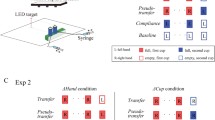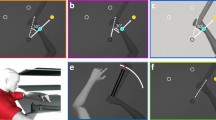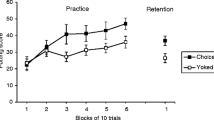Abstract
To lift an object, the motor system must predict the weight of the object and use this information to program appropriate lifting forces. If this prediction is erroneous, people may assign blame for the error to either themselves or an external source—a process called credit assignment. In the present study, we explored the role of credit assignment on weight predictions during a lifting task. Participants were told that the EMG surface electrodes attached to their lifting hand were either part of a “passive” system that recorded muscular activity, or part of an “active” system that would apply energy to the muscle, influencing weight perception. Participants performed 90 lifts of the training blocks, followed by 10 lifts of a newly encountered larger test block. In between training and test trials, the experimenter turned off the recording system and removed the surface electrodes for participants in the “active” group. For each lift, we determined the initial peak rate of change of vertical load force rate and load-phase duration, estimates of predicted object weight. Analysis of the first 10 training lifts and the last 10 training lifts revealed no effect of Active versus Passive EMG on weight predictions. However, after removing the EMG equipment, participants in the “active” group failed to scale their predictive load forces in the same manner as those in the “passive” condition when lifting a novel block. We conclude that cognitive information may play a role in credit assignment, influencing weight prediction when lifting novel objects.



Similar content being viewed by others
References
Baugh LA, Kao M, Johansson RS, Flanagan JR (2012) Material evidence: interaction of well-learned priors and sensorimotor memory when lifting objects. J Neurophysiol 108:1262–1269
Brodie EE, Ross HE (1984) Sensorimotor mechanisms in weight discrimination. Percept Psychophys 36:477–481
Buckingham G (2014) Getting a grip on heaviness perception: a review of weight illusions and their probable causes. Exp Brain Res 232:1623–1629
Buckingham G, Goodale MA (2010) Lifting without seeing: the role of vision in perceiving and acting upon the size weight illusion. PLoS ONE 5:e9709
Buckingham G, Cant JS, Goodale MA (2009) Living in a material world: how visual cues to material properties affect the way that we lift objects and perceive their weight. J Neruophysiol 102:3111–3118
Buckingham G, Wong JD, Tang M, Gribble PL, Goodale MA (2014) Observing object lifting errors modulates cortico-spinal excitability and improves object lifting performance. Cortex 50:115–124
Criscimagna-Hemminger SE, Donchin O, Gazzaniga MS, Shadmehr R (2003) Learned dynamics of reaching movements generalize from dominant to nondominant arm. J Neurophysiol 89:168–176
Criscimagna-Hemminger SE, Bastian AJ, Shadmehr R (2010) Size of error affects cerebellar contributions to motor learning. J Neurophysiol 103:2275–2284
Diedrichsen J, White O, Newman D, Lally N (2010) Use-dependent and error-based learning of motor behaviors. J Neurosci 30:5159–5166
Fercho K, Baugh LA (2014) It’s too quick to blame myself-the effects of fast and slow rates of change on credit assignment during object lifting. Front Hum Neurosci 8:554
Flanagan JR, Beltzner MA (2000) Independence of perceptual and sensorimotor predictions in the size-weight illusion. Nat Neurosci 3:737–741
Flanagan JR, Wing AM (1997) The role of internal models in motion planning and control: evidence from grip force adjustments during movements of hand-held loads. J Neurosci 17:1519–1528
Flanagan JR, Bowman MC, Johansson RS (2006) Control strategies in object manipulation tasks. Curr Opin Neurobiol 16:650–659
Flanagan JR, Bittner JP, Johansson RS (2008) Experience can change distinct size-weight priors engaged in lifting objects and judging their weights. Curr Biol 18:1742–1747
Gordon AM, Forssberg H, Johansson RS, Westling G (1991) Integration of sensory information during the programming of precision grip: comments on the contribution of size cues. Exp Brain Res 85:226–229
Gordon AM, Westling G, Cole K, Johansson RS (1993) Memory representations underlying motor commands used during manipulation of common and novel objects. J Neurophysiol 69:1789–1796
Hatada Y, Miall R, Rossetti Y (2006) Two waves of a long-lasting aftereffect of prism adaptation measured over 7 days. Exp Brain Res 169:417–426
Huang VS, Shadmehr R (2009) Persistence of motor memories reflects statistics of the learning event. J Neurophysiol 102:931–940
Huang VS, Haith A, Mazzoni P, Krakauer JW (2011) Rethinking motor learning and savings in adaptation paradigms: model-free memory for successful actions combines with internal models. Neuron 70:787–801
Hwang EJ, Smith MA, Shadmehr R (2006) Dissociable effects of the implicit and explicit memory systems on learning control of reaching. Exp Brain Res 173:425–437
Johansson RS, Cole K (1992) Sensory-motor coordination during grasping and manipulative actions. Curr Opin Neurobiol 2:815–823
Johansson RS, Westling G (1988) Coordinated isometric muscle commands adequately and erroneuously programmed for the weight during lifting task with precision grip. Exp Brain Res 71:59–71
Jones LA (1986) Perception of force and weight: theory and research. Psychol Bull 100:29–42
Kagerer FA, Contreras-Vidal JL, Stelmach GE (1997) Adaptation to gradual as compared with sudden visuo-motor distortions. Exp Brain Res 115:557–561
Klassen J, Tong C, Flanagan JR (2005) Learning and recall of incremental kinematic and dynamic sensorimotor transformations. Exp Brain Res 164:250–259
Kluzik J, Diedrichsen J, Shadmehr R, Bastian AJ (2008) Reach adaptation: what determines whether we learn an internal model of the tool or adapt the model of our arm? J Neurophysiol 100:1455–1464
Krakauer JW, Ghez C, Ghilardi MF (2005) Adaptation to visuomotor transformations: consolidation, interference, and forgetting. J Neurosci 25:473–478
Lackner JR, DiZio P (2005) Motor control and learning in altered dynamic environments. Curr Opin Neurobiol 15:653–659
Malfait N, Ostry DJ (2004) Is interlimb transfer of force-field adaptation a cognitive response to the sudden introduction of load? J Neurosci 24:8084–8089. doi:10.1523/JNEUROSCI.1742-04.2004
Miall RC, Wolpert DM (1996) Forward models for physiological motor control. Neural Netw 9:1265–1279
Michel C, Pisella L, Prablanc C, Rode G, Rossetti Y (2007) Enhancing visuomotor adaptation by reducing error signals: single-step (aware) versus multiple-step (unaware) exposure to wedge prisms. J Cogn Neurosci 19:341–350
Mon-Williams M, Murray AH (2000) The size of the visual size cue used for programming manipulative forces during precision grip. Exp Brain Res 135:405–410
Newell KM (1991) Motor skill acquisition. Annu Rev Psychol 42:213–237
Oldfield RC (1971) The assessment and analysis of handedness: the Edinburgh inventory. Neuropsychologia 9:97–113
Pang X, Tan HZ, Durlach N (1991) Manual discrimination of force using active finger motion. Percept Psychophys 49:531–540
Pelisson D, Alahyane N, Panouilleres M, Tilikete C (2010) Sensorimotor adaptation of saccadic eye movements. Neurosci Biobehav Rev 34:1103–1120
Redding GM, Wallace B (1996) Adaptive spatial alignment and strategic perceptual-motor control. J Exp Psychol Hum Percept Perform 22:379–394
Shadmehr R, Mussa-Ivaldi FA (1994) Adaptive representation of specific dynamics during learning of a motor task. J Neurosci 14:3208–3224
Smith MA, Ghazizadeh A, Shadmehr R (2006) Interacting adaptive processes with different timescales underlie short-term motor learning. PLoS Biol 4:e179
Thoroughman KA, Shadmehr R (2000) Learning of action through adaptive combination of motor primitives. Nature 407:742–747
Wolpert DM, Diedrichsen J, Flanagan JR (2011) Principles of sensorimotor learning. Nat Rev Neurosci 12:739–751
Zwislocki JJ, Goodman DA (1980) Absolute scaling of sensory magnitudes: a validation. Percept Psyophys 28:28–38
Author information
Authors and Affiliations
Corresponding author
Rights and permissions
About this article
Cite this article
Fercho, K., Baugh, L.A. Cognitive attribution of the source of an error in object-lifting results in differences in motor generalization. Exp Brain Res 234, 2667–2676 (2016). https://doi.org/10.1007/s00221-016-4670-0
Received:
Accepted:
Published:
Issue Date:
DOI: https://doi.org/10.1007/s00221-016-4670-0




